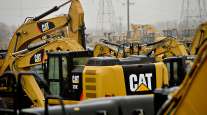Caterpillar Sued Over Heavy-Duty Engines
By Frederick Kiel, Staff Reporter
This story appears in the Aug. 9 print edition of Transport Topics.
Three trucking companies are suing Caterpillar Inc. over the sale of what their legal counsel says are “defective” 13- and 15- liter diesel engines for heavy-duty trucks.
The Texas law firm representing the companies now is looking for fleets to join the litigation.
The engines were produced be-tween 2007 and 2009 and received Environmental Protection Agency certification that they met federal pollution standards.
“Caterpillar has sold more than 20,000 of the 15-liter engines with the 2007 technology, and a still unknown number of the 13-liter models,” Warren Armstrong, a lawyer at Miller Curtis & Weisbrod LLP, Dallas, told Transport Topics.
Caterpillar, for years the largest producer of heavy-duty truck engines, announced June 2008 it was leaving that business and wouldn’t make products to comply with EPA’s 2010 emissions regulations.
Miller Curtis filed the lawsuit March 8 in the Bowie County state court in Texarkana, Texas. The lawsuit is still in the discovery stage and no trial date has been set.
Armstrong said, “Our investigation shows that both [engines] have the same record of constant breakdowns, and our lawsuit involves reimbursement of lost profits, engine value and other monetary damages due to what we allege is a defective design and a failure to correct the defects to the satisfaction of our clients,” he added.
Besides Caterpillar, the suit also cites as defendants Caterpillar distributor Warren Power & Machinery Inc., and truck dealer Rush Enterprises, New Braunfels, Texas. Rush is the dealer that sold the trucks to the Oklahoma-based plaintiffs: Daryl Thomason Trucking Inc., Paul Transportation Inc. and John Tapley Forestry Service Inc.
Both Caterpillar and Rush Enterprises declined comment.
“Trucking firms came to us with their problems with Caterpillar engines, because the engines were experiencing the same failures over and over again,” Armstrong said in explaining his firm’s involvement.
The lawsuit initially named the three trucking firms as plaintiffs, but Armstrong said that through word of mouth and ads placed in trucking publications, the firm has added dozens of new plaintiffs, which he declined to name.
One Miller Curtis ad with a headline of “Caterpillar C13/C15 Engine Problems?” ran in the July 26 issue of Transport Topics (p. 10).
Caterpillar, Peoria, Ill., said in 2008 it would stop producing heavy-duty commercial engines rather than making what it called a
major investment to meet EPA’s tougher emission rules for 2010.
The company was the market leader in Class 8 engine sales for about eight years before falling behind Cummins Inc. in 2007. Sales slumped further as dealers and technicians raised complaints about engine performance (11-12-07, p. 5).
Armstrong said that Caterpillar’s regeneration system technology provides active regeneration in the diesel particulate filter, the device all engine makers added in 2007.
“It is supposed to work by increasing the exhaust temperature when the temperature isn’t high enough to burn the soot,” Armstrong said. “What happens is that the system injects fuel into a combustion chamber to create a flame to increase the temperature of the exhaust to burn off or oxidize the soot in the DPF.”
However, Armstrong said, “Therein lies the problem. Whether it’s a clogged after-treatment regeneration device head or other issue, the engine is not regenerating correctly, and the engine will then often derate or shut down.”
A truck dealer who asked not to be identified said that 90% of his customers once ordered Caterpillar engines.
“Dealing with Cat engines became a real nightmare since 2007,” the dealer told TT. “I don’t even remember anymore what major software fix we’re on now — all trying to correct the ‘re-gen’ issue. We’ve had to spend a lot of time nursing our clients who bought them.”
He added that from speaking to many other dealers, “The problem is widespread throughout the nation,” though he scoffed at the allegation that Caterpillar knew the engines were defective.
Ronald Szapacs, maintenance specialist at the private fleet run by Air Products & Chemicals Inc., Allentown, Pa., said his company once bought trucks equipped with Caterpillar engines.
“We had valve actuator issues, and we’re having a huge number of valve springs break in Cat engines, starting in 2007,” Szapacs said.
“We’ve had to do a complete re-build of many engines, and the bearings on the C-13 just don’t last as long,” Szapacs said.
He said that he thought Caterpillar, which was once diligent about servicing its engines, laid off many of its service personnel after withdrawing from the market.
“These Cats have cost a lot more to maintain, and they’ve had a lot more downtime,” Szapacs said. “If Cat would go back to heavy-duty, we certainly would not look at them because of the way they walked away from us.”




